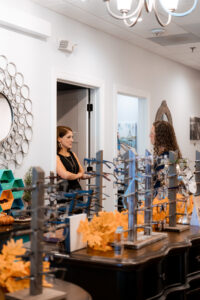
Dr. Foster (in doorway) conversing with a customer in her optical. She says a few key changes did wonders for her eyewear capture rate.
Specific actions that increase eyewear capture rate.
By Kara Foster, OD
August 30, 2023
Capturing eyewear sales that would otherwise go to an online retailer or big-box store is no easy feat. In our practice, we have implemented a few strategies that have made a huge difference to our success at doing this.
Our capture rate went from 44 percent for all non-contact lens exams in 2018 to 65 percent in 2022. Here is how we did it.
Offer Competitively Priced Eyewear Packages
Offer packages that are comparable in price to online and big-box prices, but include MORE. Our packages have inclusive lenses with ALL lens features rather than features that must be purchased a la carte.
This gives the patient the best lenses without them having to sacrifice quality or feel like they are paying extra for features such as AR, scratch resistance, UV treatments and other lens treatments. Picking all these features individually can start to add up. We offer it all for one price.
Reach out to your lab rep and find out if the lab offers “in-house” or “in-stock” lenses for less than surfaced lenses. This helps keep your costs down, while still enabling you to provide a high-quality product.
We have been offering all inclusive pricing since we opened in 2015 as part of our direct-care approach, but put together our cost-effective package in 2017.
Our three eyewear packages:
Single-vision: $129
Bifocal: $199
PAL: $299
All these packages come with polycarbonate lenses, a standard hard-coat, non-glare, UV coating, anti-scratch coating and two-year warranty. We then give the patient an overall price quote that is inclusive of the charges for any extras I recommend like Transitions and blue-light protection.
Successfully selling eyewear packages required training for our team to be able to explain to patients at the right time that we are competitive with big-box stores while offering the patient the best options. Many patients automatically assume that independent practices are more expensive.
Patients could buy eyewear packages from an online retailer or at a big-box store, but I believe they get a better-quality product buying from us, along with the customer service that often comes from buying from a smaller, independent retailer.
Patients who purchase our eyewear packages are happy with the personalized care they receive in our optical and are more receptive to getting a higher-end lens next time because we’ve explained the differences between the package lenses and the higher-end options.
Other Articles to Explore
I recommend trying to identify the patients who seem like they want to walk with their prescriptions and start off by explaining your package pricing and everything that’s included. Your optical team can then reinforce that message during the hand-off.
I also suggest dropping vision plans or offering packages outside of insurance that are reasonably priced. If you’re out-of-network, you can offer all-inclusive pricing, with all the upgrades in a package price, and easily file claims for the patient, so they are able to use their benefit and get the frames and lenses they need without having to use insurance co-pays or labs required by the insurance company.
>>Click HERE to read how Dr. Foster successfully dropped managed-care plans, and is now helping other practices do the same.>>
Educate Patients About the Importance of Proper Measurements & Fitting of the Frame
We explain to our patients that to have the best success with new glasses, and their vision, proper measurements and correct fitting of a frame are important, especially when wearing a multifocal. Don’t be afraid to tell patients something like this: “Glasses are like jeans. The size may be the same with different retailers, but the fit is usually not the same. It’s important to try the frames on in-person to make sure you’re getting the best fit and feel.”
As part of our direct care approach, we spend significant time customizing the experience for the patient. Since we stopped accepting insurance in 2017, we have been able to spend more time with patients to tailor our refraction and glasses fitting to their needs. If a patient tries another store or online retailer, rather than buying from us, they usually come back the following year because they are able to see the difference.
Pull the Frames in Advance
This has been one of the most effective strategies in our optical. Often, patients tell me they get overwhelmed with the selection process. Having 8-10 pairs pre-selected, based on the patient’s prescription and face shape, helps narrow down on the overwhelming selection process AND the amount of time a patient spends walking around looking. It gives a personal touch, as well. Patients feel catered to, and appreciate the one-on-one time with the optician.
We started pre-selecting frames for our patients in 2016 as yet another way to give them a more personalized experience. It shows the optician is prepared for them and helps them quickly see a selection of what we offer if they don’t want to look around immediately.
During our team meetings, we talk a lot about how we can improve our patient experience. We all agreed that pre-selecting frames was a great way that we could add value and show off our frame selection without coming across as too pushy to patients.
I train my opticians to pay attention to patients’ current glasses during lensometry, and assess the patient’s face shape before they go into the exam room. If time allows, the optician can also check the finalized Rx before the patient comes out of the exam room. This will help them get an idea of their current style and also help guide them to select a frame to fit their face shape and Rx.
Our opticians are also trained to choose frames that suit the patient’s daily needs, whether they are primary glasses, sports frames, hobby glasses, computer glasses, etc.
Patients who are on the fence about looking at frames in your office, or are in a hurry, are more likely to purchase when the decision is faster and easier for them.
 Kara Foster, OD, is the owner of EyeCare for You in Apex, N.C., and now also helps other practices reduce, or eliminate, dependence on managed care. To contact her: drkara@directcaredifference.
Kara Foster, OD, is the owner of EyeCare for You in Apex, N.C., and now also helps other practices reduce, or eliminate, dependence on managed care. To contact her: drkara@directcaredifference.

























